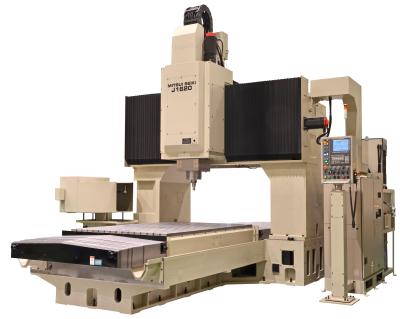
Mitsui Seiki USA Inc. announces a new series of large, highly accurate CNC jig mills for producing mold bases, mold plates, precision hot runners, progressive and transfer dies, and other jig boring and milling applications. The fixed cross-rail, massive ram design of the J1620 and J1620X machines provides a straightness accuracy in X and Y axes better than 10 microns, according to the company. Further, table squareness to the Z-axis is also better than 10 microns.
“The accuracy of these machines is really unparalleled,” said Thomas Dolan, vice president. “Our design offers significantly tighter control in boring operations than conventional moving/sliding cross-rail configurations.”
Working size range is for the J1620 is 2,100mm (X) x 1,600mm (Y) x 500mm (Z). Table size is 2,400mm x 1600mm with a load capacity of 4,000kg. With the J1620X version, all the specifications are the same except X-axis is 2,500mm and the table is 2,200mm x 1,500mm. A variety of CNC U-axis boring heads are available on both models. The machines feature a 10,000-rpm built-in integral spindle with a 50-taper interface. The spindle technology controls growth and provides thermal stability. Customers can choose from a variety of toolchanger units with capacities from 10 to 180 tools and more. Likewise a variety of coolant and chip evacuation systems can be chosen to match the customer’s needs. Ultraprecise probing is also an option as an aid to workpiece setup and in-machine inspection functions. The popular FANUC 30i-B control combines user-friendliness and exceptional levels of accuracy, reliability and efficiency. Machine enclosure and guarding options on the jig mills meet current environmental, health and safety standards.
Contact Details
Related Glossary Terms
- boring
boring
Enlarging a hole that already has been drilled or cored. Generally, it is an operation of truing the previously drilled hole with a single-point, lathe-type tool. Boring is essentially internal turning, in that usually a single-point cutting tool forms the internal shape. Some tools are available with two cutting edges to balance cutting forces.
- computer numerical control ( CNC)
computer numerical control ( CNC)
Microprocessor-based controller dedicated to a machine tool that permits the creation or modification of parts. Programmed numerical control activates the machine’s servos and spindle drives and controls the various machining operations. See DNC, direct numerical control; NC, numerical control.
- coolant
coolant
Fluid that reduces temperature buildup at the tool/workpiece interface during machining. Normally takes the form of a liquid such as soluble or chemical mixtures (semisynthetic, synthetic) but can be pressurized air or other gas. Because of water’s ability to absorb great quantities of heat, it is widely used as a coolant and vehicle for various cutting compounds, with the water-to-compound ratio varying with the machining task. See cutting fluid; semisynthetic cutting fluid; soluble-oil cutting fluid; synthetic cutting fluid.
- gang cutting ( milling)
gang cutting ( milling)
Machining with several cutters mounted on a single arbor, generally for simultaneous cutting.
- jig
jig
Tooling usually considered to be a stationary apparatus. A jig assists in the assembly or manufacture of a part or device. It holds the workpiece while guiding the cutting tool with a bushing. A jig used in subassembly or final assembly might provide assembly aids such as alignments and adjustments. See fixture.
- jig boring
jig boring
High-precision machining (a sophisticated form of milling) that originally pertained to jig and fixture manufacturing. Basic jig-boring processes include centering, drilling, reaming, through and step boring, counterboring and contouring.
- milling
milling
Machining operation in which metal or other material is removed by applying power to a rotating cutter. In vertical milling, the cutting tool is mounted vertically on the spindle. In horizontal milling, the cutting tool is mounted horizontally, either directly on the spindle or on an arbor. Horizontal milling is further broken down into conventional milling, where the cutter rotates opposite the direction of feed, or “up” into the workpiece; and climb milling, where the cutter rotates in the direction of feed, or “down” into the workpiece. Milling operations include plane or surface milling, endmilling, facemilling, angle milling, form milling and profiling.
- toolchanger
toolchanger
Carriage or drum attached to a machining center that holds tools until needed; when a tool is needed, the toolchanger inserts the tool into the machine spindle. See automatic toolchanger.
